As labour shortages, increasing costs, and the push for more sustainable practices become ever more pressing, these machines have become a promising solution for addressing key challenges in modern wine production.
But just how good are they? Which robots are best for different tasks, and what are the economics of integrating this technology into vineyard operations? Furthermore, with the potential tightening of labour laws – especially in California, where immigrant workers are crucial to the industry – could the demand for robotic labour increase? Let’s see...
How good are the latest vineyard robots?
Vineyard robots have evolved significantly in recent years, combining advances in artificial intelligence (AI), robotics, and machine learning to handle a range of tasks that were once performed exclusively by human labourers. While early models were crude and limited in their capabilities, today’s robots are becoming increasingly sophisticated, demonstrating high levels of precision and efficiency.Some of the most notable advancements in vineyard robots involve their ability to perform complex tasks such as pruning and harvesting. For example, robots can be programmed to identify specific vines and prune them in ways that optimise growth and grape production, or to remove leaves in the canopy to ensure optimal sunlight exposure.
Another area of significant improvement is weed management. Robots use advanced sensors and AI to identify weeds and selectively remove them, avoiding any damage to the surrounding vines. Unlike traditional mechanical weeding, these machines can work with a much higher level of precision, reducing the need for herbicides and minimising environmental impact.
Naïo Technologies, a pioneer in agricultural robotics, is currently testing the simultaneous execution of two tasks, such as soil work and canopy management, to optimise its robots for producers.
In strawberry and apple growing, there have been significant leaps in harvesting technology. Machines such as Octinion’s Rubion and FFRobotics’ robotic harvester use machine vision, sophisticated algorithms, and adaptive grippers to harvest ripe strawberries and apples (respectively) in a way that mimics human picking. But 24 hours a day.
Grape-picking machines – as opposed to vine-shaking machines – are few and far between. The most exciting one is the new prototype from Slovenia’s PeK Automotive. Its Grape Picker (main photo and below) is a hinged attachment for the Slopehelper agrosystem and preserves the integrity of grape bunches by cutting the stems – enabling whole-bunch pressing and grape sorting.
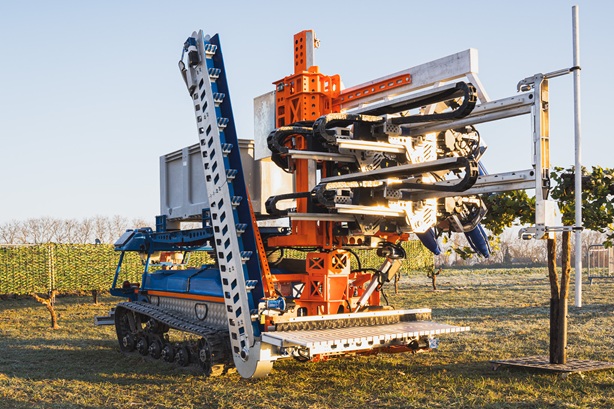
“This innovation is excellent for companies specialising in sparkling and high-quality wine production, where oxidation is unacceptable,” says CEO Dr Mikhail Kostkin. The Grape Picker ensures quality and efficiency in the grape harvesting process, and is a viable alternative to hiring seasonal harvesting workers.”
While robots have yet to fully replicate human dexterity and decision-making in every facet of vineyard work, they are steadily improving, and their performance is approaching a level where they can be relied upon for many labour-intensive tasks.
Best machines for different tasks in the vineyard
Each autonomous machine has been specifically designed for a particular set of tasks. The key challenge for vineyard managers looking to integrate robotics into their operations is identifying which machines suit their needs and what tasks should be automated. Here’s a breakdown of some of the best machines available for specific tasks in the vineyard…Alternatives to tractors
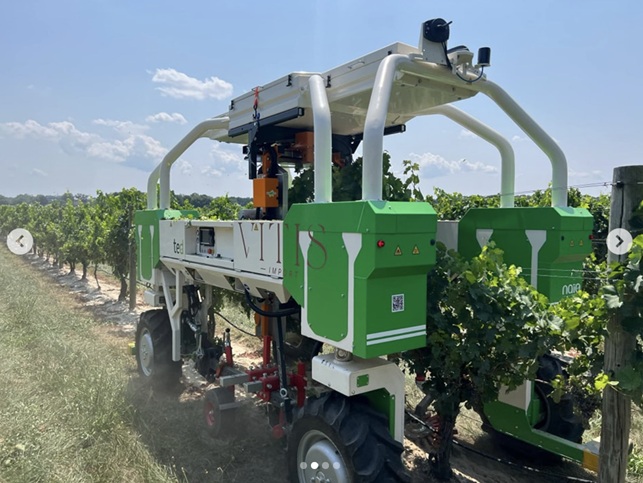
Naïo Technologies’ Ted (above) is an autonomous vineyard straddle robot which can be remotely monitored via smartphone using the Naïo Companion app. Developed in partnership with the French Institute of Vine and Wine, Ted can perform a variety of tasks including soil work (using ridge removers, inter-row blades, discs, and cultivators) pruning and mechanical weeding. New this year is the Naotec vine shoot remover implement which is designed to delicately but thoroughly clean vines down to the base of the graft.
Ted can also collect data on vine health. Using integrated sensors developed by Chouette, the robot can detect diseases and provide other valuable insights from the field. Ted can also do two jobs at once, such as pruning and mechanical weeding.
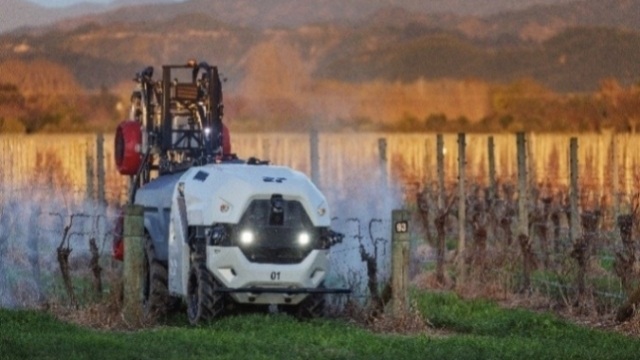
New Zealand-based agritech company Robotics Plus has launched Prospr (above), an autonomous, multi-use, hybrid diesel-electric vehicle for vineyards and orchards.
Prospr has a modular architecture, advanced AI capabilities, and all-day running that tackles various tasks, including automated intelligent spraying. The manufacturer says the machine can adapt to different tools, crop types, growing formats, and applications throughout the year to maximise return on investment for growers.
Dr Alistair Scarfe, co-founder and chief engineering officer at Robotics Plus, says Prospr’s autonomous capabilities, including advanced artificial intelligence, pave the way for a more efficient, safe and sustainable viticulture industry.
Weed control
Naio Technologies’ Jo (above) is designed for weeding. This low-compaction electric crawler tackles weeds on the row and between rows with a single pass. Jo can also set furrows with RTK GPS positioning.
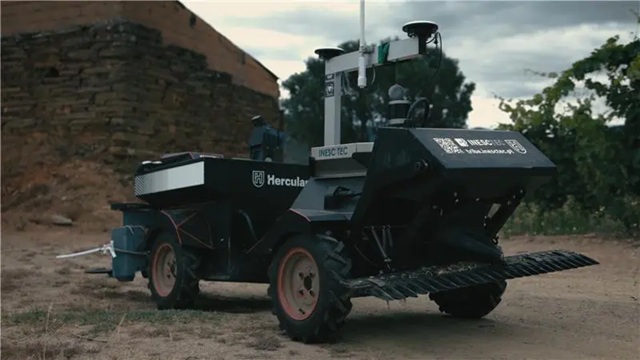
INESC TEC, a Portuguese private non-profit association dedicated to research and technological development in digital technologies and robotics, showed Modular-E (above) at this month’s FIRA exhibition in France. Modular-E is an electric and cost-effective modular ground robot designed to support various agricultural tasks through the attachment of specialised tools. These include soil monitoring, weed removal/control, spraying, and fertilisation. The latest tool is designed for intra-row and inter-row weed management in steep slope vineyards. In the pipeline for next year are pruning and harvesting capabilities.
Exxact Robotics’ TRAXX is a diesel-powered autonomous straddle tractor for soil cultivation (discs, inter-row blades, kress stars) and spraying with confined recovery panels in narrow vineyards. Equipped with a 56hp engine and a 110L diesel tank, TRAXX can work for 30 to 35 hours with a fuel consumption of 3 to 4 litres per hour.
The TRAXX Concept H2 (above) is powered by a hydrogen fuel cell. In addition to its environmental benefits, hydrogen makes it possible to create a machine that is quieter and recharges quickly in 15 minutes, while allowing 12 hours of work.
Harvesting
PeK Automotive’s Slopehelper Grape Picker attachment is designed to preserve the integrity of your grape bunches with its non-shaking grape picker. Working effortlessly on slopes and paired with a gravity-stabilised harvesting bin, this Slovenian-built machine can also do most jobs in the vineyard that a tractor can do. But autonomously. We have been following its development since 2021 (see our original report here).
The fully autonomous system is capable of performing all harvesting operations, including picking (by cutting the stems), loading/unloading and delivering baskets directly to the winery gates. All with only two operators:
- One operator in the field to oversee the fleet of harvesting robots, autonomous forklifts and transportation platforms.
- Another operator to oversee the handoff from the transportation platforms to the winery itself.
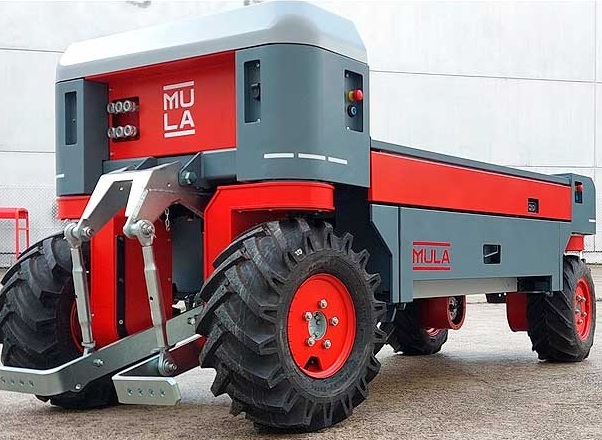
MULA Autonomous Robots unveiled the MULA 1250 U4 (above), the latest version of its multipurpose electric autonomous vehicle platform, at FIRA 2025 earlier this month.
MULA’s platforms integrate with a wide range of existing commercial implements, enabling them to perform diverse tasks such as hauling, towing, weighing, spraying, sowing, mowing, and harvesting. The Spanish company is also developing specialised implements for the platform, such as a berry harvester.
Monitoring and analysis
VineRobot’s robot is equipped with sensors to monitor the health of vines, collecting data on factors such as soil moisture, temperature, and disease pressure. This data can then be used to guide vineyard management decisions and optimise crop yield.
Rover by WineGrid offers real-time vineyard monitoring, providing key data points on soil conditions, water usage, and vine health.
Helping inexperienced tractor drivers
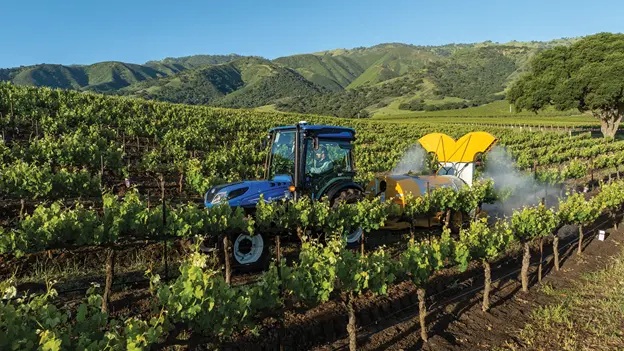
The specialty tractor New Holland T4 FNV now has an advanced guidance system that was developed to help address the lack of skilled operators faced by many growers. The Advanced Vision Assisted Guidance is LiDAR-based and manages steering movements both in the rows and at row ends, in addition to rear implement control. As a result, it is effective in situations where GPS-based systems are not a solution.
Economic considerations: costs and benefits
The integration of vineyard robots comes at a cost. Initial investments in robotic equipment can be substantial, with prices for a single machine ranging from €20,000 to €200,000, depending on the complexity and function.However, the economic advantages are clear in the long term. By automating labour-intensive tasks, vineyard owners can reduce their reliance on seasonal workers, lower labour costs, and increase operational efficiency.
That said, the initial cost of purchasing a robot remains a hurdle for many smaller-scale producers. For smaller operations, sharing equipment or leasing it from companies offering robotic vineyard services could be an affordable entry point.
Will Trump’s crackdown on illegal agricultural workers in California increase interest in vineyard robots?
In California, where labour shortages are a growing concern, particularly in the agriculture industry, robots may provide a solution to the challenges posed by both immigration restrictions and a declining workforce willing to work in the fields. The Trump administration’s crackdown on illegal agricultural workers could lead to significant labour shortages in vineyards, where many workers are migrant labourers from Latin America.However, driverless vehicles are not yet permitted in California, even in privately-owned fields.
As vineyard owners face a dwindling labour pool, the appeal of autonomous machines becomes more pronounced. Robots could serve as a reliable, scalable, and legal alternative to immigrant labour, particularly in regions where vineyards depend heavily on seasonal workers. In the long term, this shift could alleviate the pressure that producers are facing due to increasing labour costs and the unpredictability of workforce availability.
Aymeric Barthès, CEO of Naïo Technologies, points out another benefit of robots regarding labour: “Robotics not only makes vineyard work more efficient but also more appealing to the younger generations who are drawn to advanced technologies.”
Another thing making vineyard robots more attractive despite their price tags is the push for sustainability and minimal environmental impact, as they create a lower carbon footprint compared to traditional farming methods and robotic weeders reduce the reliance on chemicals.
When will robots fully take over vineyard work?
Despite the significant strides in robot technology, complete automation in vineyards is still several years away. For tasks like pruning and delicate fruit picking, human workers are likely to remain an essential part of the workforce for the foreseeable future. While robots are already proving successful in certain tasks, such as weeding and data collection, tasks requiring more nuanced decision-making, dexterity, and judgment – like assessing fruit ripeness or managing irregularities in vine growth – are still better suited for human expertise.The widespread adoption of robots will depend not only on technological advancements but also on economic factors such as cost, availability of labour, and regulatory considerations. As technology improves, however, it’s likely that the range of tasks robots can handle will expand, making them indispensable in vineyard management.
Conclusion: A new era in viticulture
The rise of autonomous machines in vineyard work signals a pivotal shift in the wine industry. While robots are far from replacing human labour entirely, they are already proving to be valuable tools for increasing efficiency, reducing costs, and mitigating the impact of labour shortages. As technology continues to improve, and as economic and political pressures make labour more difficult to secure, robots could become a staple in vineyards worldwide.For wine producers, the challenge will be in understanding how to integrate this new technology into existing operations, and balancing the initial investment with long-term gains in efficiency and quality. Ultimately, vineyard robots are more than a trend – they are becoming a vital tool for the future of viticulture.

 English
English French
French







.png)


